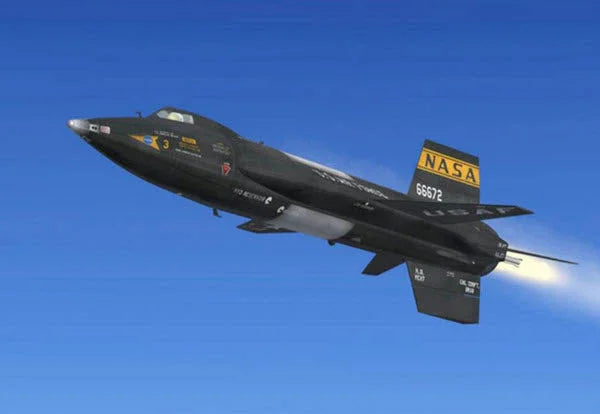The World's First Hypersonic Rocket Plane - The X-15

Scott Crossfield prepares for a flight in the North American Aviation X-15A
The X-15 is a mid-wing monoplane with dorsal and ventral fin/rudders and stabilators. The wing has no dihedral while the stabilators had a pronounced -15 degree anhedral.
Dihedral of the wing of an aircraft is the upward angle from the horizontal of the wings of an aircraft, while anhedral is the negative degree slope from the wing base.

Image showing the difference between dihedral and anhedral wing configurations.
The wings are very short and have an area of 200 square feet and a maximum thickness of just 5%. The leading edges are swept 25.64 degrees. The X-15 had two small flaps but no ailerons.
The entire vertical fin/rudder pivots for yaw control.
Starting on June 8, 1959, the three X-15s were flown 199 times by twelve different pilots, three of whom would qualify as astronauts.
One of them, Neil Armstrong, was the first human to set foot on the surface of the moon on July 20, 1969.
Flying this rocket plane involved sitting in a nitrogen gas-pressurized cockpit wearing a David Clark MC-2 full-pressure suit with an MA-3 helmet. The suit was pressurized below the neck with nitrogen, while the helmet was supplied with 100% oxygen.
The pilot had both a conventional control stick as well as side controllers.
The landing gear (an oleo strut with steerable dual wheels and two strut/skids at the rear of the fuselage. The gear is retracted after the X-15 is mounted on the NB-52 and extends by gravity for landing.
This airplane was a beautiful example of excellent supersonic aerodynamics. It sported a slender and streamlined fuselage with a pointed nose, and a very thin short, stubby wing with a leading edge as sharp as a razor blade – all designed to reduce supersonic wave drag on the airplane.
The first flight of the X-15 occurred on June 8, 1959, and the last flight took place on December 10, 1968, concluding 199 flights of the X-15.
Records
On October 3, 1967, USAF pilot William "Pete" Knight set a world speed record in an X-15 rocket plane.
Moments later, the aircraft landed charred and broken.
The ultimate goal of the program was to achieve Mach 8.
However, when the earlier X-1 and X-2 aircraft ventured toward hypersonic speeds, they ran into unsurmountable stability problems. The usual solution was to increase the size of the aircraft's tail, but the X-15 engineers realized that the ideal solution might be a change in shape as opposed to size.
So the X-15 planes emerged with a novel wedge-shaped tail: narrow at the front and wide at the back. This unusual structure kept the air streams apart during hypersonic flight and solved the stability problem.
Another problem was aerodynamic heating from friction associated with reentry at hypersonic speeds which was expected to produce temperatures greater than 2,000 degrees Fahrenheit.
No existing airframe material or insulation could withstand that kind of heat.
So the engineers came up with a unique solution: an uninsulated, exposed Inconel X hot structure. The airframe proved able to survive the ferocious heat of flight and reentry up to Mach 6, and the program achieved its goal of hypersonic flight.
To make the October 3, 1967, flight one of the X-15s was modified with two large external propellant tanks (which could be jettisoned during flight), plus a small tank for liquid hydrogen.
A special ablative thermal coating was sprayed on the X-15 to help it survive the thermal heat, but it made the aircraft heavier and harder to handle.
Returning to the flight of October 3, 1967, the revamped and renamed X-15A-2 set off on a bright and clear day. The NB-52 bomber carried the X-15A-2 up to 45,000 feet before releasing it.
Knight ignited the rocket engine and shot away from the NB-52. The engine burned for about an extra minute longer than usual because of the extra propellant carried in the external fuel tanks.
Knight shattered all previous X-15 record to set a world record of Mach 6.7, 4,519 mph!
Unfortunately, the aircraft did not survive the experience. It landed with a damaged frame, damaged wiring, skin melted in places, and some parts missing.
Knight survived, but the X-15A-2 never flew again.

X-15A-2 departing the NB-52 to set a world speed record.
It is easy to see why the X-15A-2 aircraft landed charred and broken!
This was the 188th flight of the X-15 program.
Next week we will examine some more records set by the incredible pilots and X-15 aircraft.
I hope you enjoyed this trip through some of the history of aviation.
If you enjoyed this trip, and are new to this newsletter, sign up to receive your weekly newsletter here: Subscribe here:
Until next time, keep your eyes safe and focused on what's ahead of you, Hersch!







Leave a comment
This site is protected by hCaptcha and the hCaptcha Privacy Policy and Terms of Service apply.